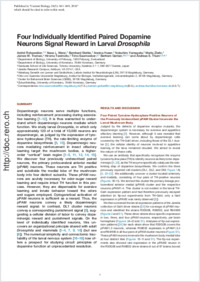Four individually identified paired dopamine neurons signal reward in larval Drosophila
- Rohwedder, Astrid Department of Biology, University of Fribourg, Switzerland - Department of Biology, University of Konstanz, Germany
- Wenz, Nana L. Department of Biology, University of Konstanz, Germany
- Stehle, Bernhard Department of Biology, University of Konstanz, Germany
- Huser, Annina Department of Biology, University of Konstanz, Germany
- Yamagata, Nobuhiro Graduate School of Life Sciences, Tohoku University, Sendai, Japan
- Zlatic, Marta Janelia Research Campus, Ashburn, USA
- Truman, James W. Janelia Research Campus, Ashburn, USA
- Tanimoto, Hiromu Graduate School of Life Sciences, Tohoku University, Sendai, Japan
- Saumweber, Timo Abteilung Genetik von Lernen und Gedächtnis, Leibniz Institut für Neurobiologie (LIN), Magdeburg, Germany
- Gerber, Bertram Abteilung Genetik von Lernen und Gedächtnis, Leibniz Institut für Neurobiologie (LIN), Magdeburg, Germany - Otto von Guericke Universität Magdeburg, Institut für Biologie, Verhaltensgenetik, Magdeburg, Germany - Center for Behavioral Brain Sciences (CBBS), 39106 Magdeburg, Germany
- Thum, Andreas S. Department of Biology, University of Fribourg, Switzerland - Department of Biology, University of Konstanz, Germany - Zukunftskolleg, University of Konstanz, Germany
-
07.03.2016
Published in:
- Current Biology. - 2016, vol. 26, no. 5, p. 661–669
English
Dopaminergic neurons serve multiple functions, including reinforcement processing during associative learning [1, 2, 3, 4, 5, 6, 7, 8, 9, 10, 11 and 12]. It is thus warranted to understand which dopaminergic neurons mediate which function. We study larval Drosophila, in which only approximately 120 of a total of 10,000 neurons are dopaminergic, as judged by the expression of tyrosine hydroxylase (TH), the rate- limiting enzyme of dopamine biosynthesis [ 5 and 13]. Dopaminergic neurons mediating reinforcement in insect olfactory learning target the mushroom bodies, a higher-order “cortical” brain region [ 1, 2, 3, 4, 5, 11, 12, 14 and 15]. We discover four previously undescribed paired neurons, the primary protocerebral anterior medial (pPAM) neurons. These neurons are TH positive and subdivide the medial lobe of the mushroom body into four distinct subunits. These pPAM neurons are acutely necessary for odor-sugar reward learning and require intact TH function in this process. However, they are dispensable for aversive learning and innate behavior toward the odors and sugars employed. Optogenetical activation of pPAM neurons is sufficient as a reward. Thus, the pPAM neurons convey a likely dopaminergic reward signal. In contrast, DL1 cluster neurons convey a corresponding punishment signal [5], suggesting a cellular division of labor to convey dopaminergic reward and punishment signals. On the level of individually identified neurons, this uncovers an organizational principle shared with adult Drosophila and mammals [ 1, 2, 3, 4, 7, 9 and 10] (but see [6]). The numerical simplicity and connectomic tractability of the larval nervous system [ 16, 17, 18 and 19] now offers a prospect for studying circuit principles of dopamine function at unprecedented resolution.
- Faculty
- Faculté des sciences et de médecine
- Department
- Département de Biologie
- Language
-
- English
- Classification
- Biological sciences
- License
-
License undefined
- Identifiers
-
- RERO DOC 259402
- DOI 10.1016/j.cub.2016.01.012
- Persistent URL
- https://folia.unifr.ch/unifr/documents/304886
Other files
Statistics
Document views: 141
File downloads:
- pdf: 244
- Supplementary material: 146

